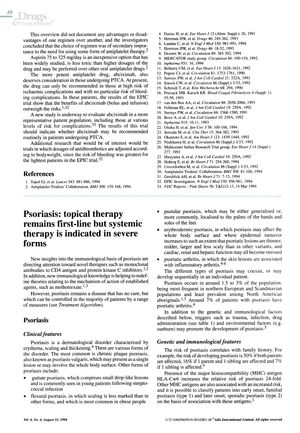Psoriasis
August 1994
in “
Drugs & Therapy Perspectives
”

TLDR Psoriasis treatments range from topical creams to systemic medications with serious side effects, and while treatments can manage symptoms, there is no cure.
The 1994 document provides an overview of psoriasis, affecting 1.5 to 3% of the population, and its treatment options. Topical therapies like tar, dithranol, calcipotriol, and corticosteroids are first-line treatments for mild to moderate cases, while severe cases may require systemic treatments such as photochemotherapy, methotrexate, and retinoids, which have serious side effects and require monitoring. Retinoids are effective in over 75% of patients with certain types of psoriasis but are teratogenic. Cyclosporin is also effective but can cause hypertension and renal dysfunction. Other treatments have limited indications or are not recommended. Systemic corticosteroids are used only for short periods to avoid exacerbation of psoriasis upon withdrawal. The document notes drug-induced hair growth changes, which typically normalize after stopping the drug, and mentions scalp cooling to reduce drug-induced alopecia, though its effectiveness is uncertain. Treatment for psoriasis is palliative, not curative, and patient discussion is crucial for determining treatment suitability.





